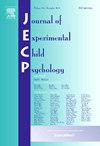The wind in the willows effect: Does age affect human versus animal faux pas recognition?
IF 1.8
2区 心理学
Q3 PSYCHOLOGY, DEVELOPMENTAL
引用次数: 0
Abstract
Children’s literature is rife with anthropomorphic or non-human characters that may be used as a scaffold to teach children about theory of mind (ToM) or the ways in which people think or feel about the social world. In this study, 107 typically developing U.K. school children in Years 1, 3, and 5 (5–10 years of age) completed a human and anthropomorphic ToM test that tested their understanding of faux pas. Specifically, children from these three age groups were given a human version of 20 faux pas stories and an identical animal version of the same stories 1 week apart (with counterbalancing between classes). Pairwise comparison showed that participants in Year 1 did significantly better on the animal ToM test compared with the human ToM test, matching ToM scores of children in Year 3. On the human version of the task, there was a clear progression in age-related ToM abilities, with older children outperforming younger children and improving when the stories were human rather than anthropomorphic. Implications and future directions are discussed, in line with theories of species specialization and the importance of anthropomorphism for children.
风吹杨柳效应年龄是否会影响人类与动物的假动作识别?
儿童文学作品中不乏拟人化或非人化的角色,这些角色可以作为向儿童传授心智理论(ToM)或人们对社会世界的思考或感受方式的支架。在这项研究中,107 名发育正常的英国一年级、三年级和五年级(5-10 岁)学童完成了一项人类和拟人化心智测试,以测试他们对假冒行为的理解。具体来说,这三个年龄组的儿童在相隔一周的时间内分别接受了人类版本和动物版本的 20 个 "装腔作势 "故事(班级之间进行平衡)。配对比较结果显示,与人类 ToM 测试相比,一年级学生在动物 ToM 测试中的表现明显更好,与三年级学生的 ToM 分数相当。在人类版本的任务中,与年龄相关的 ToM 能力有明显的进步,年龄较大的儿童比年龄较小的儿童表现更好,而且当故事是人类而不是拟人化时,他们的 ToM 能力也会提高。根据物种特化理论和拟人化对儿童的重要性,讨论了影响和未来方向。
本文章由计算机程序翻译,如有差异,请以英文原文为准。
求助全文
约1分钟内获得全文
求助全文
来源期刊

Journal of Experimental Child Psychology
Multiple-
CiteScore
4.50
自引率
7.70%
发文量
190
期刊介绍:
The Journal of Experimental Child Psychology is an excellent source of information concerning all aspects of the development of children. It includes empirical psychological research on cognitive, social/emotional, and physical development. In addition, the journal periodically publishes Special Topic issues.
 求助内容:
求助内容: 应助结果提醒方式:
应助结果提醒方式:


